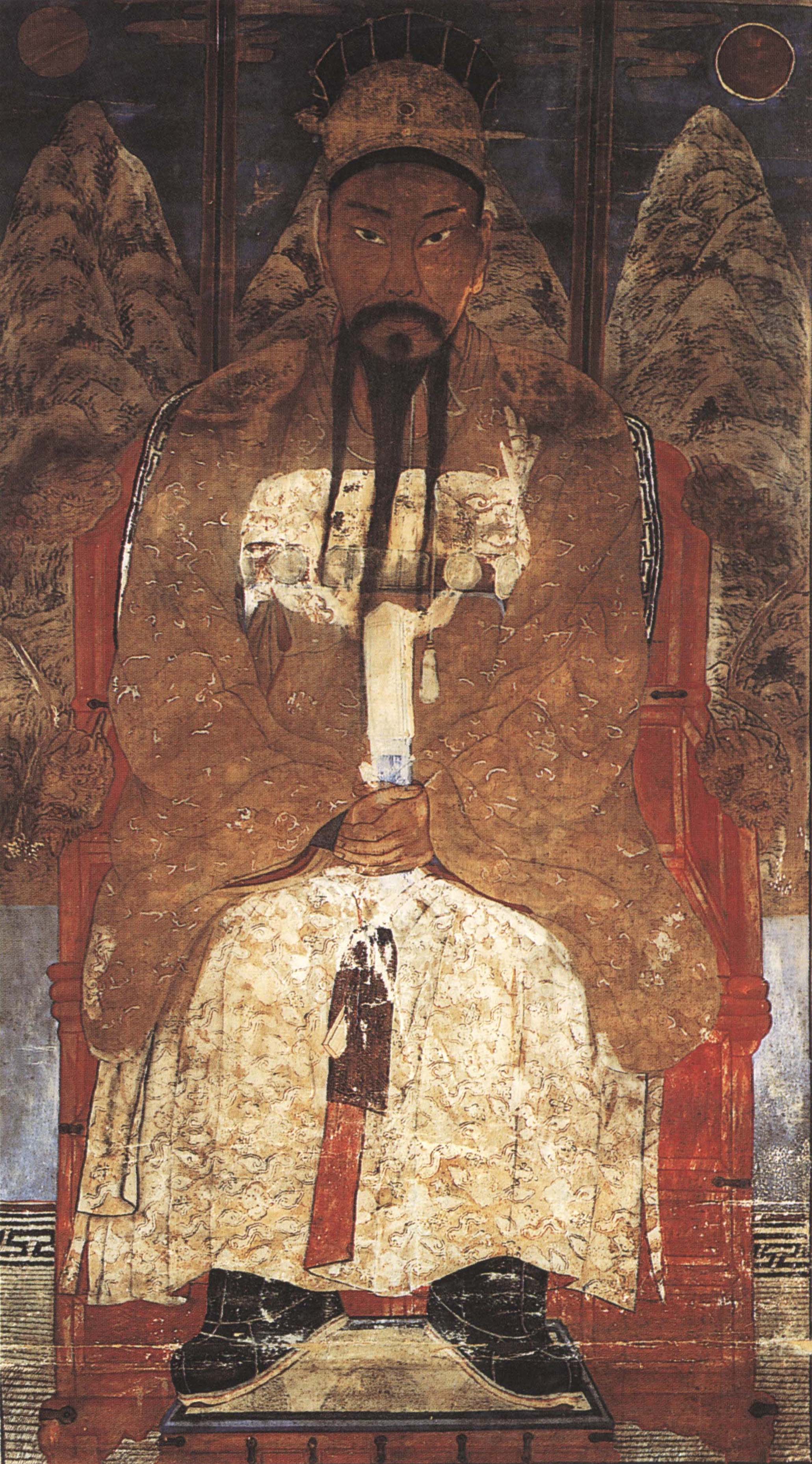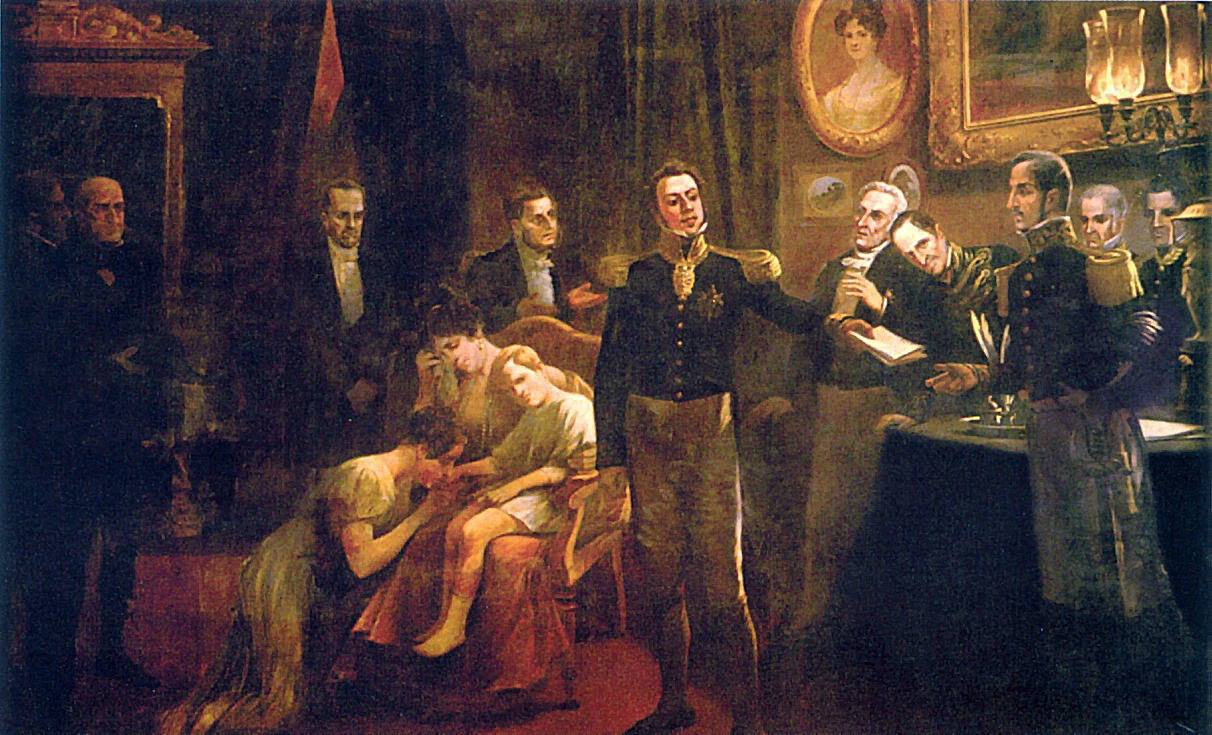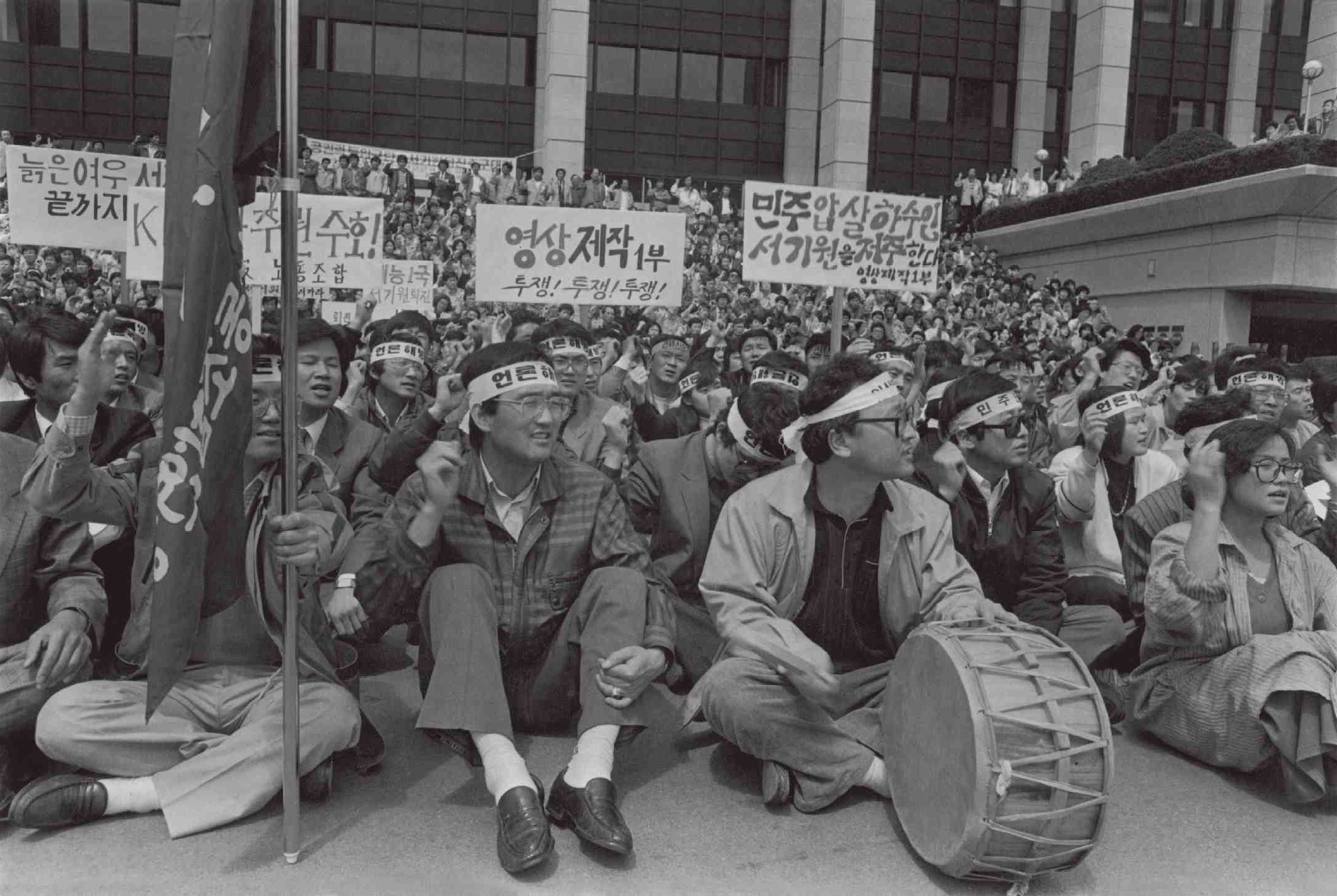|
Sinjong Of Goryeo
Sinjong (11 August 1144 – 15 February 1204, r. 1197–1204), personal name Wang T'ak, was the twentieth monarch of the Goryeo dynasty of Korea. The fifth son of King Injong, King Sinjong took the throne after his brother King Myeongjong was sent into exile by Ch'oe Ch'ung-hŏn. He was wise, but like his brother before him had no true power, which was in the hands of Ch'oe Ch'ung-hŏn (this marked the beginning of the Choe family's military rule). Sinjong's reign was marked by waves of civil uprisings, such as rebellions and uprisings in Myeongju, Jinju, Geumju, Hapcheon, Gyeongju, and Gwangju. Sinjong also witnessed the kin strife of the Choe family and soon after became ill, abdicating in favor of his son King Huijong due to Choe's demands.It is said that he begged Choe Chungheon to allow his son to rule and not to destroy the Goryeo dynasty. Family *Father: Injong of Goryeo **Grandfather: Yejong of Goryeo **Grandmother: Queen Sundeok of the Gyeongwon Yi clan *Mother: ... [...More Info...] [...Related Items...] OR: [Wikipedia] [Google] [Baidu] |
List Of Monarchs Of Korea
This is a list of monarchs of Korea, arranged by dynasty. Names are romanized according to the South Korean Revised Romanization of Korean. McCune–Reischauer romanizations may be found at the articles about the individual monarchs. Gojoseon Gojoseon (2333 BC – 108 BC) was the first Korean kingdom. According to legend, it was founded by Dangun in 2333 BC. Bronze Age archaeological evidence of Gojoseon culture is found in northern Korea and Liaoning. By the 9th to 4th century BC, various historical and archaeological evidence shows Gojoseon was a flourishing state and a self-declared kingdom. Both Dangun and Gija are believed to be mythological figures, but recent findings suggest and theorize that since Gojoseon was a kingdom with artifacts dating back to the 4th millennium BC, Dangun and Gija may have been royal or imperial titles used for the monarchs of Gojoseon, hence the use of Dangun for 1900 years. * : "An extreme manifestation of nationalism and the family cult was ... [...More Info...] [...Related Items...] OR: [Wikipedia] [Google] [Baidu] |
Abdication
Abdication is the act of formally relinquishing monarchical authority. Abdications have played various roles in the Order of succession, succession procedures of monarchies. While some cultures have viewed abdication as an extreme abandonment of duty, in other societies (such as pre-Meiji Restoration Japan), abdication was a regular event and helped maintain stability during political succession. Historically, abdications have occurred both by force (where the regnant was ''Dethronement, dethroned'', thus forced to abdicate on pain of death or other severe consequences) and voluntarily. Some rulers are deemed to have abdicated wiktionary:in absentia, ''in absentia'', vacating the physical throne and thus their position of power, although these judgements were generally pronounced by successors with vested interests in seeing the throne abdicated, and often without or despite the direct input of the abdicating monarch. Recently, due to the largely ceremonial nature of the regnan ... [...More Info...] [...Related Items...] OR: [Wikipedia] [Google] [Baidu] |
1204 Deaths
Year 1204 ( MCCIV) was a leap year starting on Thursday of the Julian calendar. Events * January 27– 28 – Byzantine emperor Alexios IV Angelos is overthrown in a revolution. * February 5 – Alexios V Doukas is crowned Byzantine emperor. * April 12 – Sack of Constantinople: Crusaders enter Constantinople by storm and start pillaging the city as part of the Fourth Crusade. Forces of the Republic of Venice seize the antique statues that will become the horses of Saint Mark. * May 16 – Baldwin, Count of Flanders, is crowned emperor of the Latin Empire a week after his election by the members of the Fourth Crusade. * Theodore I Laskaris flees to Nicaea after the capture of Constantinople, and establishes the Empire of Nicaea; Byzantine successor states are also established in Epirus and Trebizond. * Boniface I, Marquis of Montferrat, a leader of the Fourth Crusade, founds the Kingdom of Thessalonica. * The writings of French theologian Amalric o ... [...More Info...] [...Related Items...] OR: [Wikipedia] [Google] [Baidu] |
1144 Births
Year 1144 ( MCXLIV) was a leap year starting on Saturday of the Julian calendar. Events By place Levant * Autumn – Imad al-Din Zengi, Seljuk governor (''atabeg'') of Mosul, attacks the Artuqid forces led by Kara Arslan – who has made an alliance with Joscelin II, count of Edessa. In support of the alliance Joscelin marches out of Edessa with a Crusader army down to the Euphrates River, to cut off Zengi's communications with Aleppo. Zengi is informed by Muslim observers at Harran of Joscelin's movements. He sends a detachment to ambush the Crusaders and reaches Edessa with his main army in late November. * December 24 – Siege of Edessa: Seljuk forces led by Imad al-Din Zengi conquer the fortress city of Edessa after a four-week siege. Thousands of inhabitants are massacred – only the Muslims are spared. The women and children are sold into slavery. Lacking the forces to take on Zengi, Joscelin II retires to his fortress at Turbessel. There, he re ... [...More Info...] [...Related Items...] OR: [Wikipedia] [Google] [Baidu] |
13th-century Korean Monarchs
The 13th century was the century which lasted from January 1, 1201 (represented by the Roman numerals MCCI) through December 31, 1300 (MCCC) in accordance with the Julian calendar. The Mongol Empire was founded by Genghis Khan, which stretched from Eastern Asia to Eastern Europe. The conquests of Hulagu Khan and other Mongol invasions changed the course of the Muslim world, most notably the Siege of Baghdad (1258) and the destruction of the House of Wisdom. Other Muslim powers such as the Mali Empire and Delhi Sultanate conquered large parts of West Africa and the Indian subcontinent, while Buddhism witnessed a decline through the conquest led by Bakhtiyar Khilji. The earliest Islamic states in Southeast Asia formed during this century, most notably Samudera Pasai. The Kingdoms of Sukhothai and Hanthawaddy would emerge and go on to dominate their surrounding territories. Europe entered the apex of the High Middle Ages, characterized by rapid legal, cultural, and religious ev ... [...More Info...] [...Related Items...] OR: [Wikipedia] [Google] [Baidu] |
12th-century Korean Monarchs
1 (one, unit, unity) is a number, Numeral (linguistics), numeral, and glyph. It is the first and smallest Positive number, positive integer of the infinite sequence of natural numbers. This fundamental property has led to its unique uses in other fields, ranging from science to sports, where it commonly denotes the first, leading, or top thing in a group. 1 is the unit (measurement), unit of counting or measurement, a determiner for singular nouns, and a gender-neutral pronoun. Historically, the representation of 1 evolved from ancient Sumerian and Babylonian symbols to the modern Arabic numeral. In mathematics, 1 is the multiplicative identity, meaning that any number multiplied by 1 equals the same number. 1 is by convention not considered a prime number. In Digital electronics, digital technology, 1 represents the "on" state in binary code, the foundation of computing. Philosophically, 1 symbolizes the ultimate reality or source of existence in various traditions. In math ... [...More Info...] [...Related Items...] OR: [Wikipedia] [Google] [Baidu] |
Doosan Encyclopedia
''Doosan Encyclopedia'' () is a Korean-language encyclopedia published by Doosan Donga (). The encyclopedia is based on the ''Dong-A Color Encyclopedia'' (), which comprises 30 volumes and began to be published in 1982 by Dong-A Publishing (). Dong-A Publishing was merged into Doosan Donga, a subsidiary of Doosan Group, in February 1985. The ''Doosan Encyclopedia'' is a major encyclopedia in South Korea. Digital edition EnCyber The online version of the ''Doosan Encyclopedia'' was named EnCyber, which is a blend of two English words: ''Encyclopedia'' and ''Cyber''. The company has stated that, with the trademark, it aims to become a center of living knowledge. EnCyber provides free content to readers via South Korean portals such as Naver. Naver has risen to the top position in the search engine market of South Korea partially because of the popularity of EnCyber encyclopedia. When Naver exclusively contracted Doosan Doonga in 2003, the former paid multi billion won to the ... [...More Info...] [...Related Items...] OR: [Wikipedia] [Google] [Baidu] |
List Of Korean Monarchs
This is a list of monarchs of Korea, arranged by dynasty. Names are romanized according to the South Korean Revised Romanization of Korean. McCune–Reischauer romanizations may be found at the articles about the individual monarchs. Gojoseon Gojoseon (2333 BC – 108 BC) was the first Korean kingdom. According to legend, it was founded by Dangun in 2333 BC. Bronze Age archaeological evidence of Gojoseon culture is found in northern Korea and Liaoning. By the 9th to 4th century BC, various historical and archaeological evidence shows Gojoseon was a flourishing state and a self-declared kingdom. Both Dangun and Gija are believed to be mythological figures, but recent findings suggest and theorize that since Gojoseon was a kingdom with artifacts dating back to the 4th millennium BC, Dangun and Gija may have been royal or imperial titles used for the monarchs of Gojoseon, hence the use of Dangun for 1900 years. * : "An extreme manifestation of nationalism and the family cult was ... [...More Info...] [...Related Items...] OR: [Wikipedia] [Google] [Baidu] |
History Of Korea
The Lower Paleolithic era on the Korean Peninsula and in Manchuria began roughly half a million years ago. Christopher J. Norton, "The Current State of Korean Paleoanthropology", (2000), ''Journal of Human Evolution'', 38: 803–825. The earliest known Korean pottery dates to around 8000 BC and the Neolithic period began thereafter, followed by the Bronze Age by 2000 BC, Jong Chan Kim, Christopher J Bae, "Radiocarbon Dates Documenting The Neolithic-Bronze Age Transition in Korea" , (2010), ''Radiocarbon'', 52: 2, pp. 483–492. and the around 700 BC. The |
Age Of Warriors
''Age of Warriors'' () is a South Korean historical television series. It aired on KBS1 from February 8, 2003, to August 15, 2004, every Saturday and Sunday at 21:45 ( KST) for 158 episodes. It's KBS' third histocal series set in Goryeo after ''Taejo Wang Geon'' and '' The Dawn of the Empire'', and the largest TV production of the time, with over 130 major actors and a total production cost of 30 billion won. Written by Yoo Dong-yoon and directed by Yoon Chang-bum and Shin Chang-suk, the series covers 50 years of the military rule over Goryeo, from the coup in 1170 until the death of Choe Chung-heon in 1219, and was filmed predominantly on open sets at Mungyeong, North Gyeongsang, and Jecheon, North Chungcheong. ''Age of Warriors'' recorded a viewership rating of 20–23% in about a month after its first broadcast. It was appreciated for its non-stop battle scenes, the fast story development, and the detailed and realistic portrayal of the endless plots and massacres to seiz ... [...More Info...] [...Related Items...] OR: [Wikipedia] [Google] [Baidu] |
Korean Broadcasting System
The Korean Broadcasting System (KBS; ) is the public broadcasting, national broadcaster of South Korea. Founded in 1927, it is one of the leading South Korean television and radio broadcasters under the government of South Korea. The KBS operates seven radio networks, ten television channels and multiple Internet-exclusive services. Its flagship terrestrial television television station, station, KBS1, broadcasts on Television channel, channel 9 while KBS2, an entertainment-oriented network, broadcasts on channel 7. KBS also operates the international service KBS World, which provides television, radio and online services in 12 languages. History Early radio broadcasts The KBS began as Gyeongseong Broadcasting Station () with call sign JODK, established by the Governor-General of Korea on 16 February 1927. It became the in 1932. After Korea was liberated from Japanese rule at the end of World War II, this station started using the call sign HLKA in 1947 after the United St ... [...More Info...] [...Related Items...] OR: [Wikipedia] [Google] [Baidu] |
Queen Sundeok
Queen Sundeok of the Gyeongwon Yi clan (; 15 April 1094 – 21 September 1118) or formally called as Queen Mother Mungyeong (), was a Korean Goryeo era queen consort as the second wife of Yejong of Goryeo and the mother of his successor, Injong of Goryeo. Biography Early life The future Queen Sundeok was born on 15 April 1094 as the second daughter of Yi Cha-gyŏm and Lady Ch'oe, the second daughter of Choe Sa-chu from the Haeju Choe clan. She had six brothers, one older sister, and two younger sisters. Since King Munjong's reign, the Gyeongwon Yi clan was already produced many queen consorts or wives for the Goryeo royal family, so it can said that she came from a noble family. Marriage and Palace life She firstly entered the palace in 1108 (3rd year reign of Yejong of Goryeo) at 15 years old and was given the royal title as Princess Yeondeok () and was put to live in Yeondeok Palace (). One year later, she gave birth to their first son, Wang Hae (the future King Injong) and ... [...More Info...] [...Related Items...] OR: [Wikipedia] [Google] [Baidu] |






